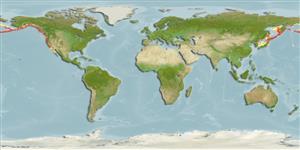分類 / Names
俗名 | 同種異名 | Catalog of Fishes(屬, 種) | ITIS | CoL | WoRMS | Cloffa
Teleostei >
Perciformes/Zoarcoidei (Eelpouts and pricklebacks)
鱸形目 (Eelpouts and pricklebacks) >
Zoarcidae (Eelpouts)
綿鳚科 (Eelpouts) > Lycodinae
Etymology: Lycodes: Greek, lykos = wolf + Greek, suffix, oides = similar to (Ref. 45335); diapterus: From the Greek di and apteros meaning 'two' and 'fin' (Ref. 27436).
More on author: Gilbert.
Environment: milieu / climate zone / depth range / distribution range
生態學
海洋 深海底的; 深度上下限 146 - 844 m (Ref. 80505), usually 300 - 600 m (Ref. 80505). 深水域
North Pacific: Southern California west of the Channel Islands north along the North American coast to the Pacific side of Vancouver Island; apparently not present in the Strait of Georgia or Puget Sound, and has been reported as far south as San Diego.
北太平洋: 到在 Aleutian 鏈與聖地牙哥,美國的 Attu 島的到白令海的拿瓦倫峽谷的日本海。
大小 / 重量 / 年齡
Maturity: Lm ? range ? - ? cm
Max length : 33.0 cm TL 雄魚/尚未辨別雌雄; (Ref. 2850)
簡短描述
檢索表 | 型態特徵 | 形態測量圖
背棘 (總數) : 0; 背的軟條 (總數) : 109 - 118; 臀棘: 0; 臀鰭軟條: 99 - 109; 脊椎骨: 118 - 126. This species is distinguished by the following: with scales covering the nape and the entire postorbital dorsal surface of the head (in adults 15.0 cm SL and larger): it differs from L. beringi in having higher counts of dorsal-fin ray (usually 111 or more), anal-fin ray (usually 100 or more), vertebral (usually 119 or more), and gill raker (usually 15 or more); differs from L. hubbsi in having 19-21 pectoral-fin rays (vs. 20-23), position of the first dorsal-fin
pterygiophore at the sixth or seventh interneural gap (vs. third), and color pattern, for it lacks narrow light bands extending onto dorsal fin and across nape; differs from the 'L. nakamurae group’’ (nakamurae, pectoralis, nishimurai) in having 4 postorbital pores (vs. 1 or 2), the posteriormost without a short tube; lower pectoral-fin lobe rounded, the tips of the rays rounded and the middle rays often branched, fin membrane not incised (vs. pointed, with rays pointed and unbranched, membrane moderately incised); scales often present on base of pectoral fin; light inverted V-shaped bands usually present on body (Ref. 80505).
尾部的不清楚地可與背鰭與臀鰭區別; 在中央中的胸鰭有凹槽的; 腹鰭小的.(參考文獻 6885) 腹地的暗褐色的在背面上又藍色的黑色; 在鱗片上的細突出的淡色斑點; 在背鰭上延伸的身體側邊上的 8 或 9個淡的縱帶而且在身體下半部上傳佈或分開, 變成模糊或消失當成魚時; 在胸鰭,腹鰭與臀鰭上的藍色的黑色; 在嘴與鰓腔的襯裡上的藍色的黑色; 暗色到黑色的在腹膜上.(參考文獻 6885)
Found on muddy bottoms (Ref. 2850). May be used as bait (Ref. 27436). Flesh considered firm and tasty but not esteemed (Ref. 27436).
棲息於泥底部了。 (參考文獻 2850) 可能是當作魚餌使用。 (參考文獻 27436) 肉被認為是結實而好吃的但是不讚賞.(參考文獻 27436)
Life cycle and mating behavior
Maturities | 繁殖 | Spawnings | Egg(s) | Fecundities | 仔魚
北太平洋: 到在 Aleutian 鏈與聖地牙哥,美國的 Attu 島的到白令海的拿瓦倫峽谷的日本海。
Anderson, M.E., 1994. Systematics and osteology of the Zoarcidae (Teleostei: Perciformes). Ichthyol. Bull. J.L.B. Smith Inst. Ichthyol. 60:120 p. (Ref. 11954)
人類使用
漁業: 自給性漁業
工具
特別的報告
下載 XML
網路資源
Estimates based on models
Preferred temperature (Ref.
123201): 0.8 - 5.4, mean 3.2 °C (based on 128 cells).
Phylogenetic diversity index (Ref.
82804): PD
50 = 0.5000 [Uniqueness, from 0.5 = low to 2.0 = high].
Bayesian length-weight: a=0.00120 (0.00057 - 0.00252), b=3.10 (2.91 - 3.29), in cm total length, based on LWR estimates for this (Sub)family-body shape (Ref.
93245).
營養階層 (Ref.
69278): 3.4 ±0.4 se; based on size and trophs of closest relatives
回復力 (Ref.
120179): 低的, 最小族群倍增時間4.5 - 14 年 (Preliminary K or Fecundity.).
Fishing Vulnerability (Ref.
59153): Low vulnerability (23 of 100).
